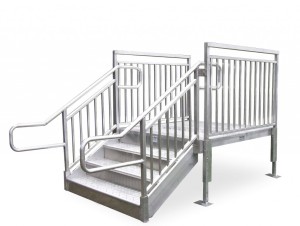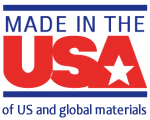OSHA regulates multiple aspects of workplace safety, including access systems. As a building owner or manager, it is essential to ensure the structural features of your facility comply with OSHA and ADA standards. REDD Team is a leading designer and manufacturer of industrial metal stairs. All our products, including stairs and generator access platforms, comply with OSHA regulations.
Landings and Platforms
 Platforms can be located within metal stairs, including the top, middle, and bottom. Industrial metal stair platforms must be at least the width of the stairs. In addition, they should be at least 2.5 feet deep. If there is a door near the platform, it should open onto the platform. In addition, the door’s swing should not reduce the platform depth to less than 1.7 feet.
Platforms can be located within metal stairs, including the top, middle, and bottom. Industrial metal stair platforms must be at least the width of the stairs. In addition, they should be at least 2.5 feet deep. If there is a door near the platform, it should open onto the platform. In addition, the door’s swing should not reduce the platform depth to less than 1.7 feet.
Guard and Mid Rails
Industrial facilities must have fall protection systems for areas with unprotected edges more than four feet from the ground or lower level. Most of our access systems or stairs come with guardrails to act as fall-protection systems.
OSHA standards require metal stairs to have guardrails that can act as handrails. In addition, the stairs are required to have mid-rails to prevent users from falling through. As the name might suggest, the mid-rail should be installed between the walking surface and the guardrail’s top edge.
Step Treads
This is the stair part you step on. Aluminum step treads are standard features of metal stairs because they offer excellent traction. OSHA regulations require step treads to be uniform in each landing platform. In addition, the minimum height of a step tread should be 0.8 feet. Also, step treads should have a minimum width of 1.8 between stringers.
Risers
This refers to the vertical area between step treads. There are two main types of risers, including solid and open-back. Some building codes prefer one type of riser over the other. OSHA requirements do not require aluminum stairs to have solid risers. However, many industrial and commercial facilities prefer to choose open-back stairs because they are generally less costly.
The height of stair risers must be uniform throughout the structure. However, riser heights must not exceed 0.8 feet. In addition, aluminum stairs are required to have footplates. The primary function of footplates is to anchor the stairs system on the ground.
It is essential to understand that some OSHA standards do not meet building codes. Therefore, avoid relying on OSHA standards alone when installing metal stairs. Over-reliance on OSHA standards could make you liable for accidents if they occur. Research local building codes to ensure the access stairs you install in your industrial or commercial facility comply with OSHA and local building codes.
REDD Team is a leading designer and manufacturer of OSHA-compliant stairs. We have been in the industry for many years and understand our clients’ needs. Our products are incredibly lightweight and portable, making it easy for you to transport them from one location to another in your facility. In addition, our aluminum stairs have excellent traction and chemical resistance. We follow all protocols for the safe design and manufacture of industrial stairs and other access systems. Our clients are industrial, commercial, municipal, and military facilities.
All our products comply with OSHA regulations. Please contact REDD Team today to discuss your next industrial metal stairs installation project.

